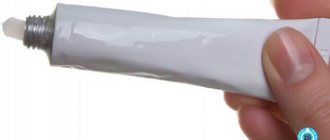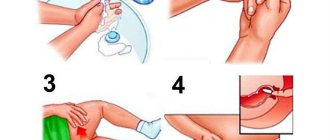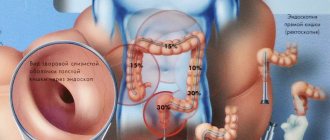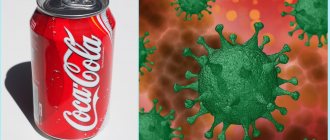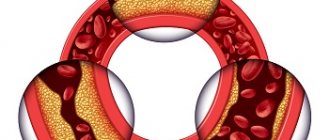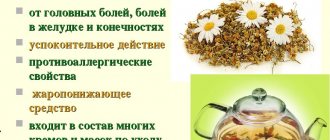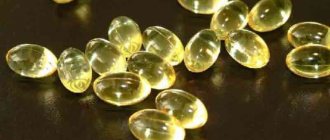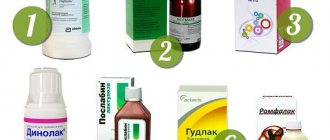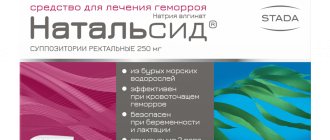Review of popular drugs
Fat-based ointments and suppositories contain the highest concentration of the active substance. The agents penetrate the mucous membrane, relieve pain and have a healing effect. To avoid excision, patients independently choose one of the most popular effective drugs.
| Name | Active substance | Description | Price |
| Argosulfan | Silver sulfathiazole | Has an anti-inflammatory, antibacterial effect. Destroys pathogenic microflora. | From 366 rub. |
| Proctosan | bufexamak | Relieves itching and inflammation, normalizes blood flow. Used twice a day. | From 427 rub. |
| Methyluracil ointment | methyluracil | An anti-inflammatory agent that activates local immunity. | From 80 rub. |
| Levomekol | Chloramphenicol | Antimicrobial, anti-inflammatory effect. Heals wounds and reduces pain. | From 140 rub. |
| Actovegin | Deproteinized hemoderivative of calf blood | Restores metabolism, improves blood flow. Relieves inflammation and promotes rapid healing. | From 640 rub. |
An anal fissure is accompanied by pain, bleeding and significantly impairs the quality of life. Ointment or suppositories should relieve inflammation, destroy bacteria on the wound, and have an analgesic effect. The duration of treatment is limited only by a medical specialist.
For children after three years
At 3-4 years old, children develop a stable intestinal microflora, strengthen their immune system, and develop an adequate body response to various stimuli, so the range of medications for treatment is expanding :
- Sea buckthorn candles . Suppositories have a pronounced restorative effect, envelop the mucous membranes, reduce itching and soreness. The only contraindication is individual intolerance and allergy to sea buckthorn. The course of treatment reaches 21 days, 1-2 suppositories per day are indicated.
- “Proctosedyl M” . The main components are the hormone hydrocortisone, framycetin, butamben, benzocaine, which provides a pronounced anti-inflammatory, analgesic, regenerating and antibacterial, angioprotective effect. The course of treatment is 10-12 days, one suppository at night.
- "Adonis " The composition includes only natural ingredients: Tambukan mud, propolis, sea buckthorn, yarrow and meadowsweet extracts. Suppositories have antipruritic, anti-inflammatory, antibacterial, and local immunomodulatory effects. At the same time, it heals wounds and stops bleeding. The course of treatment varies from 5 to 30 days, 1-3 suppositories per day.
- “Hepatrombin G” . The drug contains the hormonal component prednisolone, lauromacrogol (a substance with a mild laxative effect), sodium heparin (anticoagulant effect). The drug has antithrombotic, venotonic and venosclerosing effects and is widely used for the treatment of hemorrhoids in children and adults. Therapeutic course is 14 days, one suppository per day.
- "Immuntil" . The drug contains sea buckthorn oil, echinacea extract, cocoa butter, etc. The suppositories have a pronounced regenerating effect, restore the passage of feces, and improve the trophism of the tissues lining the membranes. The product is used 1-2 times a day for 14-21 days.
Important! If the anus is irritated, you can lubricate the skin in the perianal area with Vaseline and sea buckthorn oil.
Use of suppositories
Rectal suppositories simplify treatment. Constant dosage, ease of use, rapid absorption of active ingredients. Substances do not enter the liver and are not absorbed into the blood. The active substance fights the disease, and the auxiliary components:
- relieve pain;
- envelop the mucous membrane;
- soften stool;
- have a slight laxative effect.
Candles are made with a fatty base, often cocoa butter. Rectal suppositories are used after bowel movements and hygiene procedures. Each drug comes with instructions indicating the dosage. The doctor can select an individual number of suppositories per day. The cause of changes may be the severity of the disease, intolerance to the concentration of a certain component.
It is recommended to administer no more than two suppositories per day. It is recommended to lie down for about half an hour after administration. The active substance is absorbed into the surface of the mucosa and begins to act. Depending on the drug, the patient begins to feel better within 30-40 minutes after installing the suppository.
Rules for using suppositories for anal fissure
Candles must be used correctly!
Candles are very easy to use. However, there are some recommendations that will help make the treatment even more effective:
- Before using candles, be sure to wash your hands with soap. No infection should get into a bleeding fissure. This can lead to serious complications.
- Most suppositories are stored in the refrigerator because they spread quickly when warm. If the candles were stored at room temperature, they should be placed in the refrigerator for a while. Conversely, if the candle is too hard and cold, you need to warm it up a little in your hands.
- If you need to insert half a candle, for example, into a child, you can only cut it with a clean disposable blade directly in the wrapper. You need to cut lengthwise, not crosswise, for ease of use.
- If the candle has already melted a little, its insertion does not cause any difficulties. However, if there is severe pain or when inserting into a child, to make the process easier, lubricate the tip with a lubricant that does not contain petroleum jelly. You can do without lubricant if you just wash it with cool water.
- The suppository is administered lying down, not standing. You need to lie on one side. Straighten one leg and bend the other at the knee. The child also needs to be placed on his side.
- The suppository is inserted carefully behind the sphincter with your finger. There is no need to try to insert it as far as possible. In a child, the insertion depth is approximately 2 cm, in an adult no more than 5.
- After inserting the candle, you need to close your legs and lie in this state for about 5 minutes. This is enough for the candle to melt.
- If the candle falls out, do not reuse it, you need to get a new one.
- After the procedure, wash your hands thoroughly.
Rectal suppositories contain paraffin, oil or fat. Therefore, when the candle melts, it partially comes out. There is no need to be afraid of such leaks. All useful substances are absorbed in the rectum in the proper quantities. It is recommended to use disposable sanitary pads.
Use of painkillers
To treat fissures in the rectum, local painkillers are used. Anesthetics and antispasmodics affect the sphincter, the mucosal lesion itself. The choice of drug for women or men is no different:
- Emla
. Relieves acute pain attacks, applied in a thin layer. May be addictive, do not use for more than two weeks. Not prescribed for patients with diseases of the cardiovascular system. - Anuzol
. Relieves itching, swelling, pain relief. Used no more than twice a day, includes an antiseptic component. - Katedzhel
. Lidocaine and antiseptic in one preparation. Relieves inflammation and quickly relieves intense pain. Used by short courses. - Anestezol
. Menthol and benzocaine quickly relieve pain, relieve itching and inflammation, and dry out the crack.
A doctor may prescribe Belladonna Extract in the form of suppositories. The most commonly used drugs are benzocaine, lidocaine, and prilocaine. The drug should have a pronounced effect in severe pain. For patients, speed and force of exposure are important.
Rules of application
Suppositories should be administered only with clean hands , ideally after defecation and toileting of the perineum and perianal space. You can insert suppositories while standing, lying on your side or stomach. In young children this rarely causes difficulties.
After administration, it is recommended to lie down with your pelvis elevated : you can place a bolster or pillow. It is important to avoid leakage of the drug into the perineum, especially in girls (this increases the risk of allergic irritations).
Healing drugs
Medicines that improve local immunity and metabolism dry the wound and speed up healing. It is necessary to select venotonics that affect the source of inflammation. Often, the doctor prescribes Detralex or Troxerutin. The course is limited to a specialist but will be a minimum of eight weeks.
Healing of the crack occurs in the pathological area, so it is preferable to choose topical agents.
Rectal suppositories have gained popularity. It is noteworthy that the doctor can prescribe healing, analgesic and healing components in the form of suppositories. The film, which envelops the mucous membrane throughout the entire treatment, significantly reduces the discomfort that the disease creates. For primary and chronic forms, the following is prescribed:
- Posterisan
. Stimulates the production of immune cells and continues its cumulative effect even the next day after discontinuation of the drug. - Relief
. Relieves pain and inflammation. Heals even chronic anal fissures and is not addictive. - Ultraproct
. Restores metabolism in tissues, relieves itching and swelling. A strong hormonal drug that has a number of contraindications.
Any medicine based on pantothenic acid will do. Medicines speed up metabolism and promote faster healing. Suppositories and oils in microenemas begin to act half an hour after administration.
Peculiarities
Ichthyol suppositories are widely used in proctology and gynecology. They are intended for rectal use. Suppositories are dark brown in color and have a characteristic, recognizable odor. Thanks to the torpedo-shaped shape, the use of candles with ichthyol is greatly simplified. The basis of suppositories is solid fat.
The active substance in the drug is ichthammol. It is produced by gasification and semi-coking from oil shale resins. This natural substance has been used in medicine since the 19th century. Today, preparations based on ichthyol are intended for external and rectal use.
The drug has local irritant properties, which improves blood circulation and metabolism in tissues. This guarantees increased anti-inflammatory effects. In addition, the effectiveness of the drug is enhanced by the antiseptic properties of the active substance, which makes it possible to suppress the proliferation of pathogenic organisms.
Anti-bleeding agents
Hemorrhoids and anal fissures are accompanied by both minimal and heavy bleeding. During the normal course of the disease there is no strong discharge. Bleeding occurs with purulent inflammation, pathological disorders, complications. The drugs are used both during the period of bleeding and as a preventive measure. The situation can be aggravated by:
- hot baths, heating pads;
- the use of enemas with folk remedies;
- selection of the wrong drug;
- delaying the treatment process.
Doctors recommend starting treatment in the first stages to avoid removal or surgery. It is recommended to take a bath with a water temperature of 30-35 degrees when sphincter spasm occurs. It is forbidden to steam cracks, as this can cause bleeding.
The anti-inflammatory effect can be enhanced by ingesting decoctions of chamomile, celandine and yarrow. But it should not be combined with potent drugs. Prophylactic use of hemostatic agents helps to avoid purulent melting of blood vessels, tissue ruptures and gaping of wounds. Both targeted agents and combination drugs can be used.
What is the best method to operate on an anal fissure?
In total, there are three main methods of surgical treatment of rupture of the mucous membrane of the anal canal:
1. Scalpel
: the crack is excised and the edges of the wound are sutured. As of today, the method is practically not used anywhere due to its high invasiveness and low efficiency.
2. Laser
: using a laser beam of a given power, the edges of the crack are skinned, and the gap itself is coagulated. This method is quite painful and practically useless for treating old cracks.
3. By radio wave
: the gap is removed non-contactly using the Surgitron device, which generates a focused “beam” of radio waves that allows you to cut tissue and coagulate wounds. The method is painless and has a minimal risk of subsequent relapse.
Thus, if the patient has a choice, it is best to give preference to the radio wave method of therapy.
Review of Ultraproct candles
Treatment with suppositories for rectal fissures has many advantages. Quick effect on the source of pain and inflammation, penetration of the active substance without absorption into the blood. The targeted effect of the active components should not exceed four weeks. Then they take a break or change the medication to an analogue.
Ultraproct is a hormonal anti-inflammatory drug.
The closest analogues in terms of effect are Relief, Procto-Glivenol. Relieves itching, inflammation, reduces the intensity of pain. Prohibited for bleeding or spotting. Hexonate and fluocortolone pivalate prevent the development of pathogenic microflora. Additional benefits:
- accelerates healing:
- reduces the activity of pathogenic microflora;
- prevents suppuration;
- stops pathological processes.
Prescribed for all types of hemorrhoids, superficial fissures, anal itching and fungal infections of the mucous membrane. It is recommended to use one suppository per day, but your doctor can calculate your individual dosage. The course lasts up to seven days. Can be repeated after a short break. Relief occurs within half an hour after administration of the suppository.
Treatment tactics
Treatment of hemorrhoids in young children is carried out mainly by conservative methods , if the condition does not threaten the child’s life.
In other cases, hemorrhoids are treated through surgery, often using the Longo method and other minimally invasive methods.
Important! Conservative methods include the use of local medications (suppositories or ointments) and some folk remedies, and physiotherapy. Be sure to adjust the diet of children over two years of age, the diet of a nursing mother, and create favorable psycho-emotional and living conditions.
The effectiveness of suppositories
The main advantage of using baby suppositories is the immediate effect on pathological lesions. Other advantages:
- exclusion of absorption of active substances into the systemic circulation;
- no negative impact on the mucous membranes of the esophagus and stomach (unlike suspensions and tablets);
- convenience and ease of administration of suppositories;
- low risk of adverse systemic reactions.
We recommend: What is better for hemorrhoids: walking or lying down?
Disadvantages include the possibility of irritation of the anus and rectum due to allergies or individual intolerance, rashes in the perineum due to leakage of the medicinal composition.
Rectal suppositories Relief
Broad-spectrum vasoconstrictor. Stops bleeding, accelerates healing. The doctor selects the drug individually, based on the clinical picture. Relief Ultra and Relief Advance are often chosen from the line. Any drug:
- eliminates bleeding;
- relieves itching, burning;
- relieves inflammation;
- minimizes recurrent damage to the anus.
It can be prescribed as the only component of treatment, or for recovery after surgery. It is often chosen by patients for self-treatment at home. Indicated for hemorrhoids, anal fissures, pain during bowel movements. Eliminates internal and external discomfort during the treatment of rectal pathologies.
Contains shark liver oil and phenylephrine. The targeted action of the active components has a beneficial effect on local immunity and tissue regeneration. Suppositories are administered twice a day for two weeks. Often the doctor prescribes up to four suppositories per day.
Anal fissure: principles of diagnosis and treatment
The causes and mechanisms of development of anal fissures are varied. According to most researchers, the most common cause of cracks is mechanical. In this case, not only the consistency of the stool is of great importance, but also the anatomical features of the structure of the male and female pelvis (in the first case, posterior fissures mainly occur, while in women, who are statistically affected more often than men, anterior anal fissures predominate). At the first stage, a defect in the mucous membrane of the anal canal occurs, and then infection, cleansing and healing of the defect occur successively. As scientific research has shown, the main role in the regeneration process is played by local immunity, and the chronicity of cracks is a consequence of dysfunction of the latter. Apparently, in some cases, the root cause of the development of cracks may be inflammatory processes in the anal canal associated with a violation of local immunity. In some patients, vascular changes are a risk factor for developing the disease. Indeed, anal fissures are often combined with hemorrhoids. Eliminating blood stagnation and improving blood flow, that is, the main manifestations of hemorrhoids, contribute to the healing of cracks. The role of neurocirculatory disorders responsible for the occurrence of sphincter spasm remains very significant, although the most unexplored. The possibility of influencing this link in pathogenesis with the help of nitro drugs confirmed the importance of eliminating spasm for wound healing. Further research into the mechanisms of crack formation will help improve treatment results.
Prevalence
Approximately 10–15% of patients who seek help from a proctologist suffer from anal fissures. For many years, this disease has been ranked third in terms of treatment after irritable bowel syndrome and hemorrhoids. More than 60% of patients with anal fissure are women.
Classification of anal fissures
There is no classification of anal fissures. According to the course of the disease, acute and chronic fissures are distinguished. According to localization, they distinguish between the anterior ones, located at 12 o’clock on the watch dial, and the posterior ones at 6 o’clock (coccygeal wall of the anal canal), the latter are found in almost 90% of patients.
Clinical picture of the disease
The most common manifestation of an anal fissure is pain associated with bowel movements. As a rule, it occurs at the time of bowel movement and continues after completion of this process for about half an hour. Such clinical manifestations most often correspond to an acute anal fissure. Sometimes the pain appears with the urge to stool or is constant. Prolonged pain and little effect of analgesic therapy, as a rule, indicate the development of sphincter spasm. The latter itself is capable of increasing pain during defecation, which can lead to a vicious circle, manifested by the development of persistent spasm. Bleeding most often occurs at the moment of formation of an acute crack and is rarely profuse, although even small blood clots may be released on the first day. Subsequently, blood discharge is noted on toilet paper; less often, blood drips into the toilet. With chronic anal fissures, bleeding is often associated solely with bowel movements and rarely causes severe pain and spasm. As with hemorrhoids, the blood lost is often scarlet in color. When interviewing patients, it is possible to identify the fact of stool disorders, but it should be remembered that diarrhea leads to cracks no less often than constipation. No less dangerous in terms of the occurrence of cracks is “heavy” coarse stool, caused by ingesting a large amount of coarse fiber without a sufficient amount of liquid. In modern conditions, when collecting anamnesis, the possibility of anal sex should be clarified, which allows not only to establish the cause of the disease, but also to take measures to exclude the specific nature of the lesion. Before examining a patient, you should remember a few strict rules. The order of diagnostic procedures must be strictly observed, which always begins with an examination, which cannot be carried out in a standing position. Digital examination of the anal canal should be carried out using a gel containing lidocaine, starting manipulation from the side of the healthy wall. The absence of visual signs of the disease is not a reason to refuse digital examination and further treatment of a patient with a presumptive diagnosis. The detected changes should be interpreted taking into account the duration of the disease and the treatment performed.
When examining the anus, the patient should be correctly identified. Inspection in the lateral position requires great skill and is a necessary measure. It is preferable to conduct the examination on a gynecological chair or in the knee-elbow position with a good inward bend of the back. The last technique allows you to spread the buttocks well, in addition, you should slightly stretch the skin, and then a defect can be found on the transitional mucosa, sometimes extending to the skin. The length of the crack usually does not exceed 1 cm, although in some cases the defect can reach the length of the anal canal. With an acute fissure, the defect may be oval in shape, superficial, with smooth edges; in some cases, the bottom of the fissure may be the sphincter. The atypical lateral location of the cracks, especially in combination with the multiple nature of the lesions, most often corresponds to improper sexual contact. In the case of a chronic fissure, scars can be found, sometimes with manifestations of hyperkeratosis, the edges of the fissure are raised, its bottom is smooth, sometimes shiny, covered with “varnish granulations.” An infected crack has a dull bottom and undermined edges. The study of the anal reflex, despite the simplicity of execution, is difficult in terms of interpreting the results obtained. The results of a digital examination also largely depend on individual skills, but in any case, forced insertion of a finger into the anal canal is unacceptable. At a minimum, with an acute fissure, it is possible to detect pain in the wall of the anal canal and the manifestation of spasm at the time of its examination, especially pronounced when the dentate line zone (the border of the rectum and the anal canal) is involved in the process. With sufficient experience, it is possible to identify a defect in the mucous membrane, in the case of compaction of the edges of the crack, and detect a sentinel tubercle or hypertrophied anal papilla. Additional visual examination of the anal canal using a mirror or anoscope is carried out by proctologists.
Complications of anal fissure
The most common complications of anal fissure include the development of persistent sphincter spasm, usually accompanied by disruption of the defecation process, sometimes leading to coprostasis. Acute paraproctitis is much less common; sometimes the fissure becomes the cause of an incomplete internal fistula of the rectum. Massive intestinal bleeding occurs extremely rarely, mainly in cases of traumatic development of the fissure.
Differential diagnosis
Clinical manifestations of anal fissure do not differ in the specificity of symptoms. In case of an acute fissure or its complications, the differential diagnosis is made with acute hemorrhoids, paraproctitis, cryptitis, and rectal prolapse. It should be remembered that cryptitis and hemorrhoids are often combined with an anal fissure. Therefore, to carry out a differential diagnosis, one should rely not only on a careful history taking and digital examination (requiring great skill), but also on a visual examination using an anoscope or a rectal speculum. If a deep fissure with undermined edges, similar to an ulcer, is detected, damage to the anal canal by Crohn's disease, specific sexually transmitted infections, or the development of a tumor of the anal canal should be excluded. In patients who have had anal intercourse, injury to the sphincter, rectum, or the presence of a foreign body should be excluded. In case of any treatment of a patient with a fissure to a therapist or general practitioner, in addition to the prescription of simple conservative treatment, he should receive a referral for a consultation with a proctologist.
Conservative treatment
The choice of treatment for anal fissure is usually determined by the stage of the disease or the nature of the complications that have developed. The diet for patients with fissure excludes the consumption of alcohol, spices, and fried foods. As a rule, a protein-plant diet 3 is recommended (a high-fiber table with increased fluid intake to achieve a soft stool consistency). In patients with chronic constipation or “sheep feces”, it is permissible to recommend taking petroleum jelly or liquid paraffins for the period of treatment, but not more than three weeks. In patients with concomitant diseases of the colon, such as irritable bowel syndrome, diverticular disease or nonspecific colitis, the diet should be aimed at normalizing stool.
Patients should pay special attention to performing hygienic measures. During the acute period of the disease, a non-hot shower should be recommended 2-3 times a day and always after stool, and it is necessary to wash not only the skin of the perineum and anus, but also the anal canal itself. In cases where water procedures are not available, the use of special wet sanitary napkins should be recommended.
If a fissure is combined with hemorrhoids, drugs containing bioflavonoids (diosmin and hesperidin) should be prescribed to treat the latter.
Local therapy
The purpose of local treatment is to relieve inflammation, stimulate repair processes and analgesia. To solve the first two problems, we can recommend Posterizan Forte ointment (or candles of a similar name). The drug contains a suspension of E. coli culture and hydrocortisone. E. coli metabolites can enhance local immune responses, accompanied by the release of cytokines, especially intraleukin-1. In addition, a suspension of bacterial culture causes the formation of specific immunoglobulin A, which forms a delicate film on the intestinal mucosa, acting as a local protective barrier. Hydrocortisone, which is the second component of the drug, helps to quickly suppress inflammation and accelerates the processes of tissue regeneration induced by a suspension of Escherichia coli culture. The ointment should be administered using a special applicator while lying down. The drug is prescribed 2 times a day, and in case of severe inflammatory process, for example in patients with nonspecific colitis, the frequency of administration can be increased taking into account the frequency of stool. The maximum duration of treatment, as a rule, does not exceed three weeks. If it is necessary to continue therapy, it is possible to use suppositories or Posterizan ointment containing exclusively a suspension of bacterial culture.
Among the drugs that have an analgesic and reparative effect, Relief Advance suppositories should be recommended. The composition includes 10.3% benzocaine, which has a rapid analgesic effect, in addition, shark liver oil containing fat-soluble vitamins, free fatty acids, squalene and alkylglycerol, which are powerful reparants, which allows them to be recommended even for use in the postoperative period in patients who have undergone surgery for cracks, the frequency of administration is 3–5 times a day. In patients with difficulty defecating, suppositories can be prescribed immediately before stool. In the absence or disappearance of pain, you can switch to using suppositories or Relief ointment without painkillers. The drug is highly effective, well tolerated and rarely produces adverse reactions, which allows its use even at all stages of pregnancy. Conservative treatment of patients with severe pain or sphincter spasm, as well as in cases of relapse of the disease or combination with nonspecific colitis, should be carried out by a proctologist, since the risk of complications or chronicity of the fissure in these patients is extremely high. The use of nitro drugs for the treatment of fissures accompanied by spicter spasm is hampered by the lack of official drugs approved for use for a new purpose.
Surgical treatment of fissure
Indications for surgical treatment of anal fissure arise in case of chronicity of the process. In this case, it is important to assess the adequacy of the conservative treatment performed, as well as the nature of local changes. Quite often, patients equate the healing of an anal fissure with the disappearance of its clinical manifestations, which is a very common misconception. Therefore, the disappearance of symptoms of the disease is not a reason for refusing to re-examine the patient. In addition, in some cases, healing may be accompanied by the formation of a very rough scar or “sentinel” tubercle, that is, a small bulge of the mucous membrane at the base of the crack. Persistent sphincter spasm also indicates the lack of effect of conservative treatment. In all such situations, the patient should be referred to a proctologist to decide on the choice of further treatment method. In this case, minimally invasive manipulations include a blockade with an anesthetic and hormones or Botex injections. The use of the latter is an extremely expensive treatment method. Surgery for anal fissure involves excision of the tissue defect followed by open management of the wound until complete healing. In cases where there is a pronounced spasm of the sphincter, excision of the fissure is complemented by dosed dissection of the sphincter, the so-called lateral submucosal sphincterotomy. The duration of disability in the postoperative period is determined by the rate of healing of the postoperative wound and depends on its size and individual characteristics of regeneration. As a rule, it takes 3–4 weeks until the wound is completely epithelialized. Relapses after surgery are very rare.
Literature
- Fundamentals of coloproctology edited by Academician of the Russian Academy of Medical Sciences, prof. Vorobyova G.I. Rostov-on-Don: Phoenix Publishing House. 2001.416.
- McNally P.R. Secrets of gastroenterology trans. from English M.–S.-Pb: ZAO “Publishing House BINOM” “Nevsky Dialect”. 1998. 1023 p.
K. E. Mayat , Candidate of Medical Sciences European Medical Center , Moscow
Popular remedy Proctosan
Combined drug. It is used both for the treatment of healing cracks and in the active phase. The antibiotic in the composition stops bleeding, stops the development of pathological processes, and reduces the intensity of inflammation. Stimulates blood flow from the problem area.
In the first half hour after administration, it relieves unpleasant symptoms such as itching, pain and burning.
Eliminates symptoms during long-term treatment. A rectal antibiotic, astringent additional components, and a non-steroidal anti-inflammatory drug are used to treat ailments in the field of proctology. Prescribed for the following diseases and conditions:
- haemorrhoids;
- ailments of the anorectal area;
- rectal eczema;
- itching and burning;
- anal fissures.
Contraindicated during pregnancy and lactation. Prohibited for children and patients with hypersensitivity to the components of the drug. It is often combined with folk remedies to enhance the effect.
Cracks in the anus: causes
An anal fissure is a mechanical damage to the rectal mucosa. This disorder is common, it ranks second after hemorrhoids. It may arise as a result of:
- damage to the rectum from solid feces;
- prolonged diarrhea;
- damage to the intestine as a result of instrumental examination of the rectum, rough toilet paper or anal sex;
- birth injuries;
- weakness of the pelvic muscles;
- chronic gastrointestinal pathologies;
- Frequent lifting of weights.
The main symptoms of a fissure are constant pain, throbbing in the anus and bleeding. The danger of cracks is that they can develop into an ulcer and even a fistula.
Rectal suppositories Posterisan
A unique medicine perceived by the body as a natural remedy. Eliminates itching, inflammation, bleeding. Promotes rapid healing of anal fissures and mucosal damage. If used at the first sign of illness, the course of treatment is halved. Combined with diet, folk remedies, analgesic drugs. Prescribed for:
- anal fissures;
- perianal dermatitis;
- hemorrhoids;
- anal, genital itching;
- anopapillitis.
Used only in the absence of adverse reactions that are dose-dependent. Used even when blood is detected in the discharge. Available in the form of suppositories and ointments. The course lasts up to seven days. After a short interval, you can repeat the dose with a reduced dosage. Use from one to four suppositories per day. The ointment can be used after each bowel movement.
Posterisan is used to treat a number of diseases. A broad-spectrum drug activates local immunity and accelerates the healing of affected parts of the mucosa. It is not absorbed into the blood and does not conflict with other drugs.
Causes of hemorrhoids and anal fissures in children
Anal fissures are an increase in the lumen of the anus of a traumatic nature, which contributes to the appearance of hemorrhoids. Both diseases in childhood are reversible and are caused by the following main factors :
- Constipation . Problems with bowel movements arise due to imperfections in the lower sections of digestion, during artificial feeding or during the introduction of complementary foods. When straining, normal blood flow is disrupted and hemorrhoids enlarge.
- Dysbacteriosis. Violation of the intestinal microflora is characterized by a digestive disorder of any nature (introduction of complementary foods, drug therapy with hormones or antibiotics). Dysbacteriosis creates the prerequisites for the formation of hemorrhoids.
- Prolonged crying . Crying and screaming in babies can be caused by a number of reasons. During prolonged anxiety, intra-abdominal pressure increases, which leads to increased blood flow in the pelvic area, fissures and hemorrhoids.
- Frequent or inappropriate use of the gas outlet tube. In maternity hospitals, and then at home, it is practiced to insert a special silicone catheter into the rectal canal to quickly remove gases and reduce the symptoms of intestinal colic. Regular use injures the walls of the intestinal tract and contributes to the enlargement of hemorrhoids.
Important factors are considered to be anomalies of intestinal development , disturbances in peristalsis and the evacuation function of the intestine of any nature, and lack of adequate hygiene (including wiping the anus with rough paper or a diaper).
Additional Information
Anal fissures can be treated with suppositories and ointments. In rare cases, surgery is required. Local medications provide relief from discomfort and unwanted symptoms in a short time. A properly selected product should:
- eliminate itching and burning;
- have an analgesic effect;
- relieve inflammation;
- speed up healing.
Defects in the rectal mucosa are eliminated in a comprehensive manner. Often the course of treatment takes from one week to a month. The disease itself is eliminated within seven days, then preventive treatment is carried out. If the pathology is started, it may develop into a chronic form.
After using the suppositories, the patient should lie down for 20 to 30 minutes.
The doctor prescribes an individual dosage and prescribes a treatment regimen. To reduce the dosage, it is permissible to cut the suppository in the pack. To facilitate insertion, the tip is lubricated with Vaseline.
Indications
Ichthyol suppositories enhance the effectiveness of complex therapy for various proctological and gynecological diseases. They are prescribed for the treatment of the following pathologies:
- Salpingo-oophoritis. This disease is characterized by inflammation of the uterine appendages due to infection. A dangerous complication of the disease is the formation of adhesions, which can lead to disruption of the ovaries, disruption of the menstrual cycle and other malfunctions in the female reproductive system.
- Endometritis. Its peculiarity is inflammation of the uterine mucosa due to infection by pathogenic microorganisms. The chronic form of the disease requires long-term treatment.
- Prostatitis. The disease is associated with inflammation of the prostate gland. The disease is considered common, and various factors can trigger its development. An exacerbation, which is accompanied by severe pain symptoms, can occur against the background of hypothermia, excessive sexual activity and other external factors. Without appropriate treatment, there is a risk of developing serious complications.
Ichthyol suppositories are also prescribed for the treatment of hemorrhoids. They accelerate tissue healing, due to which the unpleasant severe symptoms of pathology disappear. The effectiveness of use depends on the stage of the disease.
